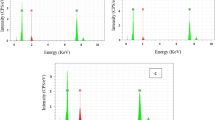Abstract
1,3-bis(1-Phenylethyl) urea was investigated as a good corrosion inhibitor for carbon steel by electrochemical techniques in 1 M HCl at a temperature range of 305–335 K. The investigation was done by electrochemical techniques such as potentiodynamic Tafel polarization and impedance spectroscopy. The calculated corrosion inhibition efficiency of inhibitor increases with their increasing concentrations. The Tafel polarization method reveals that the inhibitor acts as mixed type inhibitor. The inhibition effect of inhibitor attributed due to the adsorption on surface of carbon steel from 1 M HCl. The adsorption of inhibitor obeys the Langmuir’s adsorption isotherm. The activation parameters indicate that the adsorption process is exothermic in nature. The scanning electron microscopic measurement gives a visual idea about the formation of protective layer on carbon steel surfaces, which retards the corrosion process.









Similar content being viewed by others
References
H.L. Fan, H.B. Zheng, Inhibition of mild steel in hydrochloric acid solution by a mercapto-triazole compound. J. Mater. Chem. Phys. 77, 655–661 (2002)
M. Yadav, D. Behera, U. Sharma, Nontoxic corrosion inhibitors for N80 steel in hydrochloric acid. Chem. Sin. 3, 262–268 (2012)
I. Ahamad, M.A. Quraishi, Bis (benzimidazol-2-yl) disulphide: an efficient water soluble inhibitor for corrosion of mild steel in acid media. Corros. Sci. 51, 2006–2013 (2009)
Q.B. Zhang, Y.X. Hua, Carbon steel corrosion behavior in aqueous carbonated solution of MEA/[bmim] [DCA]. Electrochim. Acta 54, 1881–1887 (2009)
B.M. Prasanna, B.M. Praveen, N. Hebbar, T.V. Venkatesha, H.C. Tandon, Inhibition study of mild steel corrosion in 1 M hydrochloric acid solution by 2-chloro 3-formyl quinolone. Int. J. Ind. Chem. 7(1), 9–19 (2016)
S.A. Ali, A.M. El-Shareef, R.F. Al-Ghandi, M.T. Saeed, The isoxazolidines: the effects of steric factor and hydrophobic chain length on the corrosion inhibition of mild steel in acidic medium. Corros. Sci. 47, 2659–2678 (2005)
D. Jayaperumal, Effects of alcohol-based inhibitors of corrosion of mild steel in hydrochloric acid. Mater. Chem. Phys. 119, 478–484 (2010)
E.S. Ferreira, C. Giancomlli, F.C. Giacomlli, A. Spinelli, Evaluation of the inhibitor effect of L-ascorbic acid on the corrosion of mild steel. Mater. Chem. Phys. 83, 129–134 (2004)
A.M. Badiea, K.N. Mohana, Effect of temperature and fluid velocity on corrosion mechanism of low carbon steel in presence of 2-hydrazino-4,7-dimethylbenzothiazole in industrial water medium. Corros. Sci. 51, 2231–2241 (2009)
B.M. Prasanna, B.M. Praveen, Hebbar Narayana, T.V. Venkatesha, H.C. Tandon, Ketosulfone drug as a green corrosion inhibitor for mild steel in acidic medium. I&EC Res. 53, 8436–8444 (2014)
B.M. Prasanna, B.M. Praveen, N. Hebbar, Theoretical and experimental approach of inhibition effect by sulfamethoxazole on mild steel corrosion in 1 M HCl. Surf Interface Anal. (2018). https://doi.org/10.1002/sia.6457
A. Ostovari, S.M. Hoseinieh, M. Peikari, S. Hashemi, Corrosion inhibition of mild steel in 1 M HCl solution by henna extract: a comparative study of the inhibition by henna and its constituents (Lawsone, Gallic acid, α-d-Glucose and Tannic acid). J. Corros. Sci. 51, 1935–1949 (2009)
E.E. Oguzie, V.O. Njoku, C.K. Enenebeaku, C.O. Akalezi, C. Obi, Effect of hexamethylpararosaniline chloride (crystal violet) on mild steel corrosion in acidic media. Corros. Sci. 50, 3480–3486 (2008)
S. Martinez, I. Stern, Thermodynamic characterization of metal dissolution and inhibitor adsorption processes in the low carbon steel/mimosa tannin/sulfuric acid system. Appl. Surf. Sci. 199, 83–89 (2002)
Author information
Authors and Affiliations
Corresponding author
Additional information
Publisher's Note
Springer Nature remains neutral with regard to jurisdictional claims in published maps and institutional affiliations.
Rights and permissions
About this article
Cite this article
Padmashree, B., Manjunatha, K. & Prasanna, B.M. Electrochemical Behavior of 1,3-bis(1-Phenylethyl) Urea as a Corrosion Inhibitor for Carbon Steel in 1 M HCl. J Fail. Anal. and Preven. 20, 226–234 (2020). https://doi.org/10.1007/s11668-020-00822-z
Received:
Revised:
Published:
Issue Date:
DOI: https://doi.org/10.1007/s11668-020-00822-z




